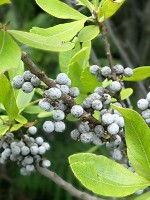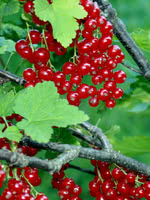Mon-Fri 9am - 5pm Mountain time
Northern Red Currant vs Northern Bayberry
Myrica pensylvanica
Ribes triste
NOT AVAILABLE THIS SEASON - MIGHT RETURN
NOT AVAILABLE THIS SEASON - MIGHT RETURN
Northern Bayberry makes an excellent hedge or feature shrub. It will retain its leaves in warmer climates but drops them in colder areas. They produce blue-grey berries that have a wax coating on them that can be used to make candles or soaps.
In colder hardiness zones the leaves turn an attractive orange to red colour in the fall, making it a striking addition to your landscape.
Northern Bayberry is native to Nova Scotia and tolerates both drought and wet conditions. It is also a nitrogen fixer that tolerates poor soil conditions.
The Northern Red Currant is also known as the Swamp Red currant due to its preference for moist soil. As long as the soil is wet, this shrub can live in any degree of sunlight.
The currant itself is a bright red-purple berry enjoyed by many animals and some people for its sour flavour, similar to garden red currants. The flowers of this shrub are tiny and red or greenish-purple.
Northern Bayberry Quick Facts
Northern Red Currant Quick Facts
Toxicity: Warning: The wax from bayberry fruit is considered toxic and may be carcinogenic.

